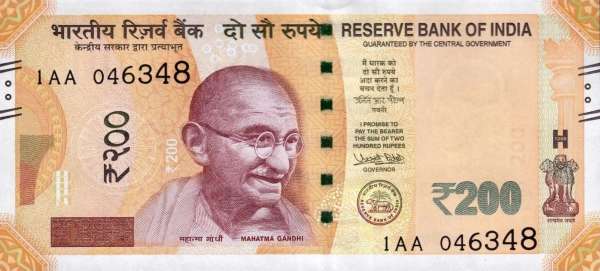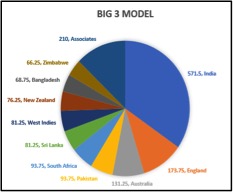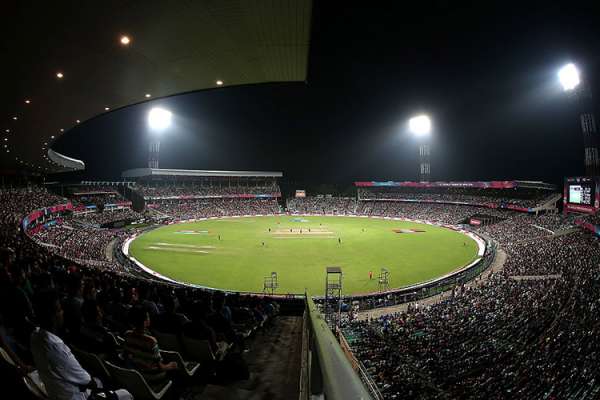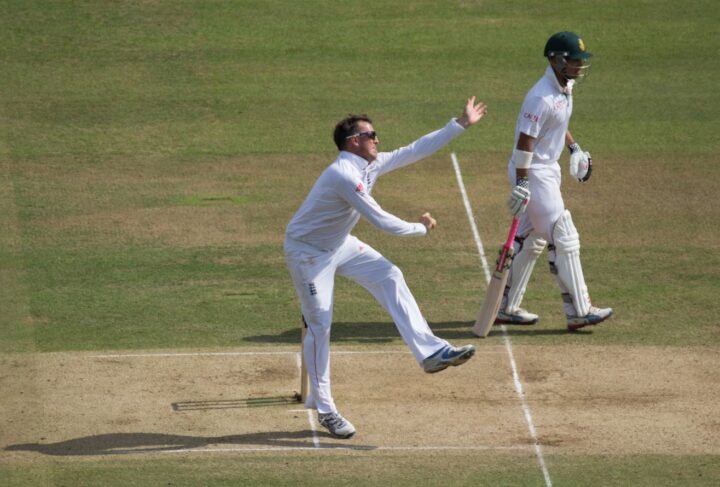With the washed out second Test giving us precious little on-field action to talk about, it’s time to once again consider the broader issues facing our sport. Today guest writer Shounak Sarkar argues that the BCCI is hindering the growth of the game worldwide. It’s a detailed analysis and a must-read …
Cricket is a great game. It deserves to have governance, including management and ethics, worthy of the sport. This is not the position at the present time. This report does not identify the causes and who is responsible for this, but it does identify the shortcomings and the action which now needs to be taken to remedy this. We have not conducted an inquest but instead have set out a vision as to the changes that need to be made and the transformation in the situation that these changes should bring about.”
These are the words found in the opening paragraphs of Lord Woolf’s report. The report was the outcome of the International Cricket Council’s decision to conduct an independent governance review in 2011. The document was a damning indictment of ICC’s governance model and outlined sweeping administrative changes in how the ICC runs the sport globally. In the report, Lord Woolf outlined several recommendations which unfortunately are just as relevant in today’s context as it was back then. Despite some positive steps taken recently, cricket remains insular, exclusive and mired in self-interest. And one of the chief stumbling blocks in cricket’s expansion is the all-powerful Board of Cricket Control in India (BCCI), who have largely taken up the mantle of holding the unofficial veto power that the English Cricket Board (ECB) and Cricket Australia (CA) held for decades over ICC.
To understand the current situation, it is important to for us to examine past events that led us here. It was the year 1993, which really served as the first catalyst for changing cricket’s course forever. Up until that year, the two Foundation Members of England and Australia held veto powers which meant that any changes to ICC constitution or membership had to be formally approved by both countries before they could be implemented. However, the continual growth of Asian Cricket in the 1980’s backed the ICC and the ECB/CA into a corner and forced a much overdue re-structure of the organisation.
The first full-time Chief Executive was appointed in 1993 and the ECB/CA both lost their veto powers; this finally meant that all Test playing countries had equal standing. It was also in 1993 that BCCI took the fateful step of selling cricket rights to the free market. They ended up striking a lucrative deal with Trans World International (TWI), which meant that for the first time it was Doordarshan who were forced to pay TWI to broadcast the games in India rather than BCCI compensating Doordarshan for telecasting the games.

1996 World Cup to IPL
The BCCI and Indian cricket continued to go from strength to strength in the 1990’s. The key figure responsible for this growth was the Kolkata based BCCI administrator Jagmohan Dalmiya. He was instrumental in the backroom negotiations, which secured the World Cup hosting rights for the Indian sub-continent away from favourites England. In 1997, Dalmiya became the first non-white and first Asian President of the ICC. The shift in power that had started in 1993 away from the Australia – England axis, now had a visible representative at ICC’s helm. In 1999, the BCCI signed a then record 5-year deal with Doordarshan, worth $7 million USD annually, setting the stage for the BCCI to become cricket’s financial powerhouse.
Dalmiya may have had a direct hand in making BCCI a financial beast, but his contributions to the world game should not be forgotten. During his three-year reign as ICC President, Dalmiya made numerous decisions that benefitted the global growth of the game. The ICC Champions Trophy concept was his idea. And for the first few editions at least, it served the dual objectives of spreading the game to then emerging nations such as Bangladesh and Kenya as well as raising additional money for the ICC in between World Cups. Dalmiya also played an influential part in Bangladesh becoming a Full Member in 2000, which marked the first time that a new test nation had joined the exclusive club in 8 years.
The next major milestone in cricket was India’s 2007 World T20 win and the subsequent creation of the T20 franchise competition, known as the Indian Premier League (IPL). Combining the glitz and razzmatazz of Bollywood with the high-octane action of T20 cricket, the IPL has grown to be a global behemoth in a little over 10 years. The value of the broadcast deal has increased exponentially and currently Star India pays the BCCI about ₹3,270 crore or $434.8 Million USD annually for the media rights. Factoring in the additional income from sponsors and partnerships, the only major expense that the BCCI face are the annual distribution costs to the 8 IPL Franchises. That leaves them with an assured annual income of $266 Million USD annually – just from the IPL alone.
In addition to the IPL, the BCCI has many further sources of income. Unfortunately, it is difficult to obtain accurate information about it on the internet because BCCI has stopped releasing audited financial statements to the public since the 2016-17 financial year. Online, there are various sources which allege annual income numbers anywhere between $US535 Million to $US2 Billion dollars a year; therefore there is much confusion.
Cynics might suggest this is rather deliberate, as BCCI wants to keep the public and other member boards in the dark about the exact amount of income that it generates. However, it is notable that despite the setbacks of COVID-19, no players or administrators at BCCI have had to take a pay cut yet. This really makes one question the intentions as well as BCCI’s justifications behind demanding a larger share of the ICC distribution pot, especially when the strength of its finances has virtually made the board COVID-19 proof.
Opposition to an Equitable Funding Model


The pie-charts above are a visual comparison between the revamped funding model that all the full members agreed to in June 2017 and the funding model that BCCI proposed during the Big 3 takeover in 2014. Whilst, the revamped model looks a lot more balanced in comparison to the lopsided Big 3 Model, people often forget that pre-2014, all full member boards received the exact same income distribution from ICC events. In fact, one can say that despite the addition of 2 new full members, universal T20 status and a reduced BCCI share of $405M, the disparity in wealth & income between the various members have never been higher. When you couple that with the short-sighted, regressive decisions of reducing the ODI World Cup to 10 teams and the ridiculous 2 stage 16 team T20 World Cup, it really begins to paint a bleak picture for associate nations. Which is ironic, considering that global participation in cricket has risen and that the standard in associate countries have improved drastically since 2014.
As things stand, the BCCI are set to receive 23% of total events revenue. But the figure they are really after is $570M USD, which would increase their slice of the pie to 32%. The BCCI argue this is justified because they contribute almost 70% of global cricket revenue and because the vast majority of cricket viewership also originates from the Indian sub-continent. So essentially from the BCCI’s perspective, the ICC and other member boards are milking the Indian TV market for money, when most of the benefits should be flowing back to India instead. This logic is faulty on multiple levels and, in the next few paragraphs, I will explain why.
A) Comparison to FIFA’s Distribution Model
The way FIFA distributes funds through its FIFA Forward 2.0 Programme is the polar opposite of the ICC. Over the 2019-2022 cycle, FIFA is poised to invest $6M USD into each of its member federations to support their operational needs and development projects. While an additional $250,000 per year is allocated to member associations with an annual revenue of less than $4M USD. The egalitarian distribution model of FIFA is particularly notable as it distributes the funds irrespective of the population, economy or revenue generation capability of their members. So a financial powerhouse team like England with its large fanbase and $6.4 Billion product English Premier League (EPL) are entitled to the same amount of investment dollars as tiny member nations like San Marino or Liechtenstein, who bring next to nothing in revenue to the FIFA table. If anything, a San Marino or Liechtenstein receives more help from FIFA, rather than the other way around.
Under the ICC’s pre-Big 3 model, the Associate boards used to receive $522M USD, which funded their development programmes and subsidised the 4-day Intercontinental Cup – the ‘supposed’ gateway tournament to Test cricket for associate nations. It is an utter tragedy then, that even after the breakup of the Big 3 and a revamp of the funding model, associate nations collectively receive only 30% of what they used to before. Former Hong Kong Cricket CEO and Emerging Cricket Founder Tim Cutler summarises the situation quite succinctly.
“If cricket ever truly wants to be a global sport it really needs to take a step back and consider its strategy, because a future where the international game stratifies to the point where it is truly dominated by a handful of teams is inevitable; unless the inequity in the way cricket distributes income from the international game is addressed. Otherwise, we risk a future where countries will drop off the radar as future players are lost to other sports and interests, and where the successes of countries like Ireland and Afghanistan coming through the system will be long distant memories.”
Say what you want about the corruption at FIFA but at least they recognise that it is the less well-off who need the most financial assistance. After all, as the international governing body of the global game, it is FIFA’s responsibility to ensure that the lower ranked teams are looked after so they can be competitive at global events. Furthermore, unlike cricket, FIFA purposely designs a tournament format where the small nations have a realistic chance of upsetting the big boys. This only serves to improve FIFA’s overall product.
B) Domestic Cricket is becoming more lucrative
BCCI fans often point to the FIFA model and say that it is unworkable in cricket because the governing bodies derive their primary income from domestic leagues rather than world events. Prior to 2008, international tours & bi-lateral cricket were the primary money generators for cricket – but this is not necessarily the case anymore. Bi-lateral cricket simply isn’t as attractive to broadcasters these days and Test cricket is barely profitable for nations unless a ‘Big 3’ team is involved. And with the advent of T20 franchise leagues, boards are profiting from domestic cricket tournaments for the first time in cricket’s history.
British journalists Tim Wigmore & Freddie Wilde in their book Cricket 2.0 – Inside The T20 Revolution predict that the future will involve a further shift away from bilateral international cricket to a sharper focus on domestic club & franchise competitions. There will be more and more T20 teams, with other national & regional T20 and T10 tournaments starting up in unlikely places such as the ones recently seen in Vanuatu, Zambia and Tajikistan. Currently, many T20 competitions lose money or only manage to breakeven. However, this can easily change if ambitions are reigned in and more commercially realistic goals are set. By forgoing the expensive marquee players and focusing instead on local talent & more modest international players, these tournaments will eventually become economically sustainable.
Consequently, the argument that the FIFA model is unworkable in cricket is no longer true. Due to the lucrative income streams from IPL, the BCCI no longer solely relies on international cricket to derive its income. They possess a phenomenally successful product at their disposal which has a current brand valuation of USD $6.3 billion – although it’s the presence of overseas stars that gives the IPL its added sheen, of course. As the game moves away from old fashioned tours to the new reality of domestic T20 leagues, Emerging Cricket’s Jay Dansinghani believes it is even more imperative that the ICC prioritizes the world game over the interests of a few powerful member boards:
Although India is a massive market, it’s contribution relative to other members is inflated because of its deliberate efforts to undermine the growth of the sport. A good example of this was their leading role in shrinking the World Cup; largely in reaction to India’s poor performance at the 2007 World Cup. Their share of the pie would, of course, be smaller if associates received more opportunities. Yet, even though they’d have a smaller share of the pie, it’s not a zero-sum game. All members stand to earn more in the long-term if the game becomes truly global.”
C) ICC is NOT milking the Indian TV market
The BCCI and its most ardent supporters argue strongly that the ICC and other cricket boards are taking advantage of the giant Indian TV market and milking its 1.3 billion population for money. They say it’s the Indian TV market that is keeping international cricket afloat by generating ratings and the advertisement dollars. As per Emerging Cricket co-host Nick Skinner, this notion is palpably false.
The crux of the ‘India gives ICC money’ argument is the unspoken assumption that the BCCI ‘owns’ all of the Indian fans who watch ICC tournaments. Which is utter nonsense. All the BCCI technically brings to the table is their logo, on the shirts of the Indian team competing. Furthermore, the ‘India gives ICC money’ argument is deliberately misleading because it assumes that nobody in India would watch ICC events without a BCCI logo involved and conflates cricket fans in India with the BCCI, which is not the same thing.”
I agree wholeheartedly with Skinner’s assessment. As cricket fans, Indian fans do possess the freedom to watch any cricket game on TV or online and are not necessarily wedded to the Indian cricket team. While it is undeniable that matches featuring India generate massive TV ratings in India, games not featuring India (whether they may be ICC tournament matches or ‘foreign’ T20 leagues such as CPL, BBL) also tend to do quite well. And there is solid evidence to back this up. The opening match between England and South Africa at the 2019 Cricket World Cup was watched by an average 114 million people in India, which compares quite favourably to the 166 million who tuned in for India vs Australia, and the 180 million who watched the India vs South Africa game.
According to BARC India, the epic 2019 World Cup Final match racked up a total of 32.4 million impressions, which also compared favourably with the 51 million impressions for the India vs NZ Semi-Final and 67 million for India vs Pakistan (unsurprisingly the tournament’s most watched game). Furthermore, in the absence of live cricket action on TV due to COVID-19, the Vanuatu T10 tournament generated a viewership of close to 500,000, with a large portion of those viewers coming from the Indian sub-continent.
The above examples clearly demonstrate that a lot of Indian viewers are perfectly willing to watch international cricket which does not feature India. Although viewer numbers do decrease for matches not involving India, the ratings still generated put to bed the absurd notion that very few people in India will watch cricket games without the BCCI. For the BCCI to claim ownership of these fans is not only belittling and disrespectful; it actually serves to suppress the often contemptible manner in which the organisation treats its own fans.
D) BCCI’s Treatment of Fans
Despite being the richest and most powerful board in world cricket, the BCCI’s track record on maintaining stadium facilities and spectator comfort is atrocious. Fans attending the India versus Australia ODI at the Wankhede Stadium in Mumbai earlier this year were left fuming at the overpriced & stale food, the chocked washbasins, and messy toilets. This was not just a one-off either. Spectator feedback shows that the issue of dirty toilets has been a persistent one for years.
Nor is this problem limited to Mumbai. Indian cricket legend Anil Kumble recently sounded the alarm about the need for BCCI to provide spectators with better facilities across the country, to keep Test cricket alive. Kumble highlighted that quite a few Indian stadiums lack comfortable seats, are in inaccessible locations, have poor transport options and terrible toilet facilities. While fans in India are willing to put up with sub-standard facilities to attend a 3-hour T20 or a One Day International game; repeating this experience across multiple days of a Test match does not sound appealing to them. Henceforth, it is not surprising that Test matches in India often suffer from low attendances.
It remains a source of constant frustration to fans that the BCCI’s financial domination of the sport and immense wealth has not translated into genuine world class facilities. The BCCI claim they require their additional funding from the ICC to grow the sport and maintain the stadium facilities but this evidence suggests they are more pre-occupied with making profits than looking after the fans who are, in many ways, the real lifeblood of the game.

Dark Clouds
In many ways, the administrative careers of BCCI chiefs Jagmohan Dalmiya and N Srinivasan exhibit the Dr Jekyll and Mr Hyde aspect of the organisation. Whereas Dalmiya was a pragmatist and a genuine cricket lover, Srinivasan is an industrialist who was belatedly introduced to cricket administration in 2002-03 by former BCCI President AC Muttiah. In fact, it is quite revealing that Muttiah has regretted that fateful decision ever since and now considers bringing Srinivasan into cricket administration as “a huge mistake”.
Srinivasan has been a deeply divisive and malignant influence on world cricket over the last decade. He was also the chief architect of the ‘Big 3 Takeover’ in 2014 which re-directed vast amounts of ICC Funding to the BCCI, ECB and CA coffers – away from smaller full members, associate nations and the ICC Development Department. Other structural overhauls included the complete executive takeover of ICC, with the Big 3 boards having permanent memberships on the executive and finance committees. Even worse, these arrangements were made in secret and were forced down the throats of smaller boards who had to vote in favour or lose the lucrative tours from the Big 3 nations.
Often accused of being unscrupulous, avaricious, ruthless and authoritarian, Srinivasan has been portrayed as the Vladimir Putin of Indian Cricket. After all, the man has built up a long rap sheet of questionable behaviour. When Srinivasan became BCCI chief in 2013, he was the de-facto owner of IPL Franchise Chennai Super Kings (CSK) through his company India Cements’ (which owned the franchise). He was also instrumental in amending an IPL regulation which stated that no administrator should have direct or indirect interest in matches or events conducted by the BCCI. This paved the way for his son-in-law Gurunath Meiyappan’s appointment as team principal at CSK. He later tried to interfere in investigations which found Meiyappan guilty of spot-fixing and betting charges related to the CSK franchise. Srinivasan refused to take any responsibility over the scandal, instead referring to his son-in-law’s investigation as an “unfair” and “motivated attack”.
In 2015, media reports revealed that Srinivasan had misused ₹14 crore of BCCI funds for personal use. In plot developments lifted straight from a spy thriller movie, this money was allegedly paid to a London based private agency to tap the phones of board officials and hack their emails. Furthermore, Srinivasan’s own son Ashwin has made scurrilous allegations that his father tried to “cure” him of homosexuality by medicating Ashwin and having him and his same-sex partner beaten up. He even went as far as cutting Ashwin off from the family fortune.
One of the legacies of the spot fixing scandal was the increased scrutiny on BCCI operations by India’s Supreme Court. Disturbed by Srinivasan’s ethics violations and flagrant disregard for the law, the Supreme Court was ultimately successful in removing him from the BCCI’s leadership position in 2014. The court then appointed a Committee of Administrators (COA) to carry out the BCCI’s operations and make amendments to its constitution to bring the BCCI in line with the minimum standards of corporate governance. However, a mere five years later, these reforms are under threat. Free from COA’s shackles, the old guard is back and BCCI have proposed sweeping changes to its constitution which dismantles every single Lodha committee recommendation. The board requires an approval from the Supreme Court to go ahead with the changes, but thankfully the Supreme Court so far has held firm.
Srinivasan is also back, pulling the puppet strings at BCCI from the background. On 13th January 2020, a select group of administrators from India (including Srinivasan), England, Australia, South Africa and New Zealand met at a luxury 5-star hotel in Mumbai to put their signatures on a letter which accused the ICC of harming cricket administration by making “arbitrary decisions without consulting the members who bring in the revenue”. The letter also demanded that the BCCI’s place at the ICC table be restored and pushed back on the idea of extra ICC events and T20 World Cup expansion.
The aforementioned events should worry all cricket fans around the world. It is clear that the Big 3 are seeking a comeback and will try to undermine the ICC at every possible opportunity. There are also reports out there which claim that former Indian captain and current BCCI Chief Sourav Ganguly is a firm favourite to win the nomination for ICC Chairman. Whilst it’s unclear whether Ganguly himself wants to run for the position, he certainly has high profile backers such as Graeme Smith and Kumar Sangakkara.
In India, Ganguly is beloved as the captain who brought mental resilience and a positive attitude to the Indian dressing room. As someone of Bengali heritage myself, I feel proud that Ganguly is the greatest cricketer that the state of West Bengal has ever produced. As a commentator he is articulate, analytical and insightful. But Ganguly in a position of power at the ICC concerns me greatly given his prior statements about getting India’s “fair share” and extracting more money from the ICC. The distinct possibility that he is being used as a political pawn by the likes of Srinivasan and Rajeev Shukla to further their agenda is even more troublesome.

Considering the strong likelihood of political power games playing out at ICC headquarters in the future, I have outlined five recommendations which are designed to improve the ICC’s governance structure and to help make it less susceptible to a hostile takeover by powerful and manipulative full member boards in the future:
Recommendations
1. Make the ICC Chairman position truly independent
Ideally, the chairman position should be totally independent and would not have held any position of influence within an existing Full Member or Associate board. The counter argument against this position is the insistence by some influential boards that an ICC Chairman needs to deeply understand the ICC Distribution Model and should have attended ICC meetings previously. Therefore I suggest a cooling off period of at least 4-5 years. This would prevent the farcical situation of someone like Ganguly serving a term as BCCI chief and then immediately becoming ICC Chairman in order to further his board’s agenda at the expense of the other 103 members.
2. Get Cricket into the Olympics
This is an absolute no-brainer. Associate nations often to have to make do with limited ICC distribution funds to plan their operations and undertake developmental activities. However, if cricket were to gain entry into the Olympics, it can unlock as much as $500,000 USD in government funds for smaller cricket nations due to cricket being recognised as an official Olympic sport. Furthermore, these funds will become available immediately and will not be dependent on the nation qualifying for the main event.
Having access to these extra funds could be a game changer in terms of exposure, development and capturing the general public’s interest. According to ICC’s own research, 87% of cricket fans surveyed worldwide support the inclusion of T20 cricket in the Olympics. So it is really only BCCI’s reluctance that is the chief stumbling block.
The problem is that the BCCI wants to avoid losing autonomy to the Indian Olympic Association as it would come under IOA’s umbrella if cricket were to gain Olympic inclusion. Furthermore, the BCCI does not want additional international T20 tournaments competing with its crown jewel product, the IPL. However, if cricket seeks a sustainable future and wants to avoid sliding down the pecking order of world sports, Olympics entry is non-negotiable.
3. Touring Teams should keep 20% of the broadcasting fees generated by host boards
There is wide consensus amongst experts that the bilateral model is broken and that bilateral tours only make money for a few select boards. Whilst the ODI Super League and World Test Championship are steps in the right direction, the tournaments do not address one major flaw of the bilateral model – only hosts make money from incoming tours.
This is a massive problem as not every country can host incoming tours due to security reasons (Afghanistan and Pakistan). Often these countries play out games to empty stands at their adopted home bases of Abu Dhabi and Dubai, missing out on precious gate revenue. Furthermore, smaller boards such as the European triumvirate of Scotland, Ireland and Netherlands face risks of home game washouts due to their rainy climates. As it is, these teams host a selected number of games over the European summer. Therefore, any washouts can have significant impacts on their revenue.
If associate teams were able to receive 20% of the broadcast revenue by touring the likes of Australia, India or England, it would spread the inflow of income through the financial year and not have everything riding on their limited cricket season. Emerging Cricket Founder Tim Cutler proposes an alternative model, where there is a central pooling of global rights shared by all boards for World Test Championship / ODI / T20I Leagues, so that the game can better plan its annual calendar and account for the costs of broadcasting and player wages etc. Such a model does involve a radical rethink of the status quo, but it might be necessary to sustain international cricket, particularly Test cricket between less wealthy boards.
4. Further Relax the Performance Criteria for Obtaining Full Membership
An ICC Full Membership comes with many perks such as additional voting rights and increased share of funding compared to Associate members. When Afghanistan and Ireland were awarded full membership in 2017, it meant that they had a direct representative on the board committee rather than coming under the Associates umbrella, where a mere 3 votes are shared amongst 92 associate boards.
Recently, the ICC have taken some positive steps towards reducing the considerable barriers to entry. As per the Membership Criteria approved on 22nd June 2017 by the ICC Council, associate nations no longer need to have a domestic 3 or 4 day competition in order to be eligible for full membership. This is fantastic as putting in place a domestic 3 or 4 day competition is expensive and needlessly prohibitive for associate nations operating on modest annual budgets. However, the guidelines set are still very difficult to achieve and would benefit from further relaxation, particularly the ones related to performance.
Until the introduction of the Cricket World Cup Super-Leagues, the haphazard & self-serving nature of the Future Tours Programme meant that Associate Nations played a pitiful number of games against the Full Member Nations and so the requirement to win 5 games against Top 10 Full Members (across World Cups, Qualifiers & Bi-laterals) is patently unfair. In fact, teams like Hong Kong, Namibia, Nepal, Oman & Papua New Guinea have never played official ODI’s against full members outside the framework of official tournaments. Therefore, this part of the ICC Performance guidelines needs to be amended with more emphasis on regular participation & qualification across the men’s, women’s and U-19 tournaments rather than on wins against full members.
Elevate the best performing associate countries such as Scotland, Netherlands and Oman to Full Membership
Once the performance guidelines have been relaxed, top associate countries like the Netherlands, Scotland and Oman need to be elevated to Full Member status as they meet many of the other criteria set out by ICC e.g. a proper governance system, ODI status, domestic 50-over and 20-over tournament structures and satisfactory junior / woman pathways with a decent level of participation.
This will have a crucial two-fold effect. Not only, will this reward countries for good performances with elevation to the top level but also provide them with benefits such as increased funding and direct voting representation at a board member level. More importantly, it will further dilute the power of BCCI and Big 3. Having 14-15 full members along with 3 associate representatives means that manipulation and intimidation of smaller boards by their bigger counterparts becomes more difficult. Furthermore, it creates an additional voting bloc between the European members of Ireland, Scotland and Netherlands or the smaller Asian members like Afghanistan, Oman and Sri Lanka who can vote together as a bloc to counter any regressive, self-interested ideas put forward by the Big 3 Boards.
Conclusion
I will leave you with these beautiful words below. This is how Indian-American comedian Hasan Minhaj finished his segment about cricket corruption on ‘Patriot Act’. The sentiment expressed here is a perfect summation of what many in the cricket community feel about the potential of cricket as a force for good, India’s financial dominance, and the BCCI’s sinister monopolising of it. Rather than seeking a revolution which overthrows the elitism and colonial mindset of cricket and opens the game to all, the BCCI instead seems determined to form a new cabal with the former imperial boards of the ECB and CA.
“The saddest part of all this is that cricket can be such a force for good. We have already seen so many inspiring examples. Afghanistan went from playing cricket in the refugee camps to playing cricket at the highest level. Their rise shows what the spread of cricket can mean to a country. As an Indian, I’m proud that we are so dominant in cricket and the game is finally exciting to watch. We took something our colonisers forced on us and we made it our own. But, my complaint is that we are so concerned with owning the sport that it isn’t about playing cricket anymore. It’s about colonising it for ourselves.”
Shounak Sarkar
The second part of this article was first published on Emerging Cricket. It has been republished here with permission.









Need a summary, far too much to wade through here.
It’s long. But that’s the price we pay for detail. You could read it in instalments like a book maybe? We don’t normally publish articles this long but it’s an important topic and I wanted to respect the author’s whole body of work. I don’t pay writers so it’s not really fair for me to ask for a shortened version either. Hope you understand, Doug.
Seemed a pretty good summation to me!
Good article. If it was a fair world the IPL would be an “international” competition with a portion of its revenues used to fund the global game. After all it has a slot in the ICC future tours program, its elbowed the t20 world cup out of the way and much of IPL’s popularity is derived from international players developed in other countries. But India, or more accurately the BCCI, are the dominant force in world cricket, the only potential counter weight is England and Australia but the ECB and ACB are even more avaricious than the BCCI. Its hard to be optimistic.
It’s the problem all international sport hasn’t these days as the men with money move in to take ownership. Their reasoning being they put the money in to raise the profile and increase the potential for profit, so they should have a controlling influence of their own investment. It’s a perfectly logical business argument, but lacks any moral purpose. All they see is a cash cow and an opportunity it’s to raise their own egotistical profiles with massive media hype.
Look at what’s happened to the footie premiership. Yes it’s nice to have the world class stars and owners with the bank balances to but them, but the bringing on of domestic talent is put on hold for short term success. Hence we have a league composed of less than a quarter of domestic players, managers and owners. This is great for world wide TV interest but not for the national team of our national sport. Young domestic talent has precious few opportunities to get game time at the expense of the so called finished articles most of whom are less than world beaters.
Cricket has a similar problem in that everyone is impatient for success, with a variety of competitions looking to poach players for their tournaments with massive pay offs. so no long term strategy exists. It puts the players in an invidious position, the public seeing them as merely greedy. The administrators prime concern is making their mark on the game whilst in office rather than seeing themselves merely as caretakers presiding over a game that’s bigger than any group of individuals. The balance between red and white ball is a delicate one and should be dealt with as a cricketing issue over profit. Many of the schemes we have to move the game forward and keep pace with the times have little solid evidence behind them to substantiate the claims of the movers and shakers. A lack of respect for any view that conflicts with their own does not show many administrators in a good light.
If we’re going to use committees in investigate then give them a balance of expertise; including players, officials, administrators and representatives of the paying public. At least then all major participating interests can have a say, rather than being sidelined in favour of a preordained plan.
I used to follow cricket governance fairly closely but have given up in the last couple of years because it was just too depressing.
Manohar said some time ago that the issue the Big Three were forgetting is that they need someone to play against. The bigger boards still seem oblivious to this. India A would give India a better game than almost any international team. However the big boards just seem to care about winning at home and listening to their media stooges proclaim what geniuses they must be as a result. It’s sickening.
I fear however that this horse has already bolted and the article is dealing with yesterday’s problem. I need to believe international cricket has any future at all first before worrying about how to make it work. Firstly, the current so-called pandemic’s implications still haven’t quite been fully grasped. When they say “the new normal” they mean it. I’m not assuming international travel and spectator activities will come back in anything like the form we’ve known them. Won’t we be told there’s a Covid-20 and -21 and -22 given how viruses are supposed to mutate? A vaccine is unlikely to be a magic bullet as there’s never been a successful vaccine for a coronavirus ever. Secondly, will sport still exist? Perhaps – it makes a heck of a lot of money and the powers-that-be probably still want “bread and circuses”. However I believe the world is being driven by globalists who want to establish global government and they can easily portray international sport as one of the few remaining sources of tensions between nations. There is a ready-made alternative in city franchises (which will only be answerable to their oligarchic owners and have none of the annoying accountability that national teams – or counties – have). I also believe they have a long-term goal of social atomisation which team sports wouldn’t fit in with. It may well be that only individual sports (notice how they love cycling) have much of a future. What remains to be seen is whether they’re going to try to jump straight into this after a coronavirus second or third wave or if it’s lined up for further down the road. The way the fear could be ramped up in the autumn, the unthinkable could become suddenly very thinkable indeed (that’s the whole point).
A couple of minor points about the article:
a) Blaming only the BCCI feels a bit like the easy option. The ECB and CA have plenty to answer for – as do many others.
b) The jibe at Putin was unnecessary. I don’t think Putin is a good guy but he isn’t any worse than almost any other leader.
Off topic James, but still having problems with posting, sometimes can see them sometimes not. Even clearing site date and cache doesn’t help.
Thanks Doug. I’ve tried so hard to eradicate this occasional problem but I’ve got nowhere. My host and the people who built the website all blame each other. I’ll ultimately find a different platform and hopefully the intermittent problem will resolve. Sorry for the inconvenience.
Sorry your having trouble, I managed to get thisvone, but I’ll probably not be posting for a while until it’s sirted, as it’s very difficult to follow topics.
Thanks for trying anyway, James! In case your host or designers are interested–and it doesn’t sound like they are!–it’s absolutely not intermittent in my case. Some variation of it happens every single time I log on and every single time I post a comment–literally–and it has for months now.
Well if the ECB needs to save 25% they should drop the wretched 100 and concentrate on the getting grass roots proper cricket back in the radar. They can also cut Harrison’s £600k a year salary while they are about it. Better still just sack him.
Hope this post gets through.
So sorry about this. It’s incredibly frustrating for me too.
DM article ‘England stars to be protected from widespread dramatic cost-cutting’ by Matt Hughes and Richard Gibson is a must-read although no surprise to anyone with two brain cells left to rub together.
The counties are staring down the barrell of a 25% cut in funding from the ECB next year. County contracts are going to be slashed in number and many more moved to part-time contracts. However England players , despite being on over £1m and having just had a 30% pay rise, are not facing any reductions. Unsurprisingly, development programmes are also on the chopping block.
The England players must stand by their county colleagues and future generations like the Australian players did in their pay dispute. The attempt to claim that England’s players deserve their pay for their sacrifices this year must seen through as the blatant sophistry it is.
This model of a super-rich elite and impoverished everyone else is where we’re all heading. White collar jobs ranging from teaching to insurance are about to be decimated by AI. The future is neo-feudalism, they’ve just weaponised the winter flu season to bring about what’s obviously been their goal for some time more quickly.
History of Indian Cricket reveals the fact that though the game was introduced by the British Government in India, its popularity kept on increasing with passing time. Cricket is now celebrated as a major sport in India. Cricket is considered to be a religion in India. There are no sure theories about the origin of Cricket in India but as British ruled on India for over 200 years, the game can be called as their legacy. The game took around four centuries to reach India. British brought this game to India in the 17th century. The first ever cricket match in India was played in 1721 AD. Initially accepted by the Parsi community, this game of foreigners began to appear in organized form with the establishment of the ‘Oriental Cricket Club’ in 1848.
https://www.indianetzone.com/28/history_indian_cricket.htm
thank you admin for sharing your knowledge with us !!! it is quite informative .. totally love it
thanks for shairing your knowledge with us! keep going on
thanks for sharing your experience
Great article. Assuming it was a fair world the IPL would be an “worldwide” contest with a piece of its incomes used to finance the worldwide game. After all it has an opening in the ICC future visits program, its elbowed the t20 world cup far removed and quite a bit of IPL’s prominence is gotten from global players created in different nations. Be that as it may, India, or all the more precisely the BCCI, are the predominant power in world cricket, the main potential stabilizer is England and Australia yet the ECB and ACB are considerably more eager than the BCCI. Its difficult to be hopeful.